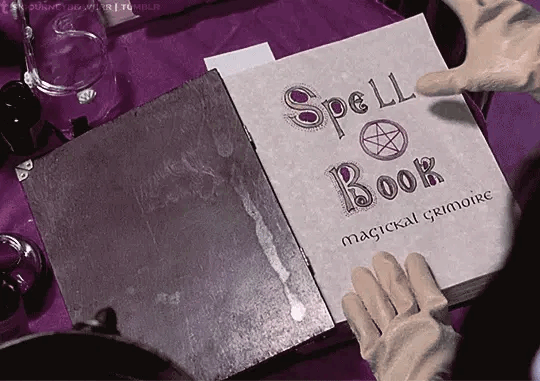#[spellbook]
Explore tagged Tumblr posts
Text
grimoire organization ideas 🔮
what is a grimoire?
a grimoire can be defined as a book of magical spells and invocations; sometimes used interchangeably with "book of shadows" but you can call it whatever you want.
what should i write my grimoire in / on?
a grimoire can be handwritten or typed, there is no wrong way to construct your grimoire. (for example, my grimoire is typed in a one note document but also stretched across many, many different notebooks and composition books)
what can i put in my grimoire?
about the author
favorites: color, magical tools, herbs, crystals
tarot birth card, astrology birth chart, personal beliefs, relationship with deities or other spiritual beings
basics
intent
visualization
meditation
terminology
protection, cleansing, & banishing using various energies: shields & wards, circle casting / take down, protective amulets
enchanting items
clockwise vs. counterclockwise
other how-to’s, such as anointing items and dressing a candle
general correspondences
days of the week, lunar phases, colors, incense, essential oils, elements
correspondences based on intent
protection, healing, cleansing, banishing, luck, wealth, love, emotions, mental clarity, psychic awareness, cursing, etc.
altar ideas
crystals
crystal grid designs, crystal correspondences & folklore, gem water / crystal elixir recipes, crystal care
herbs, spices, plants, flowers, & trees
correspondences, edible vs. non-edible, botanicals with medicinal value, folklore, gardening
divination
tarot, runes, pendulum, scrying, etc.
spreads
interpretations
astrology
birth chart + traits, planetary correspondences, planetary hours, zodiac correspondences, moon / star / sun water
sigils & symbols
how to create, personal sigils, other symbols & talismans
psychic abilities
identification of personal abilities (clairvoyance, claircognizance, clairaudience, clairsentience, clairambience, etc.)
meditation techniques to strengthen abilities
personal experiences
important dates
sabbats, wheel of the year, magical anniversaries, astronomical & astrological phenomena (meteor showers, planetary alignments, etc.)
recipes
food
potions (potions are edible and consumable liquids!!!)
beauty products: salt scrubs, sugar scrubs, lotions, lip balm
natural remedies: salves, ointments, balms, poultices
cleaning products: floor washes, window cleaner, wood cleaner, etc.
powders
witchy crafts
glitter jars, witch ladders, wand-making, crystal jewelry, etc.
spells & enchantments
sachets, spell jars / bottles, knot magic, candle spells, powder spells, curses, protective magic, etc.
magical goals
∘₊✧─────────────────────✧₊∘
good luck! ✨
© 2025 ad-caelestia
#grimoire#book of shadows#witchcraft#witchblr#beginner witch#witch#witchy#witches of tumblr#baby witch#spellcraft#magic#spellbook#ad-caelestia
1K notes
·
View notes
Text


Another surrogate, for @sozosnipes , featuring Azas Bhatta, their drow wizard! He was a massive delight to draw and I had a lot of fun experimenting with the lines here, props to anyone who may be able to guess what was I inspired by for the lineart's hatching~
#dnd#dungeons and dragons#drow#dark elf#elf#wizard#mage#fantasy#sygdomthings#syg2024#potlucksecretsatan2024#ttrpg#illustration#artists on tumblr#digital art#fantasy art#original character#character design#elves#spellbook
409 notes
·
View notes
Text

Sorry, not sorry. But I just don't give a shit about toxic bullshit.
Source
#i dont care#i dont give a shit#dark magic#spellbook#bat#halloween vibes#halloween#halloween aesthetic#spooky#spooky bitch#spooky aesthetic#spooky season#goth#gothic#goth aesthetic#dark aesthetic#alt#alternative#grunge#dark grunge#emo#scene#punk#gothgoth#gothcore#dark#darkness#sorry not sorry#skull#skulls
594 notes
·
View notes
Text
June 2024 witch guide
Full moon: June 21st
New moon: June 6th
Sabbats: Litha/Summer Solstice- June 20th
June Strawberry Moon
Known as: Aerra Litha, Birth Moon, Blooming Moon, Brachmanoth, Dyad Moon, Egg Laying Moon, Green Corn Moon, Hatching Moon, Hoer Moon, Honey Moon, Lovers Moon, Mead Moon, Moon of Horses, Moon of Making Fat, Partner Moon, Rose Moon & Strong Sun Moon
Element: Earth
Zodiac: Gemini & Cancer
Nature spirits: Sylphs & Zephyrs
Deities: Aine of Knockaine, Bendis, Cerridwen, Green Man, Ishtar, Isis, Neith & Persephone
Animals: Butterfly, frog, monkey & toad
Birds: Peacock & wren
Trees: Maple & Oak
Herbs: Dog grass, meadowsweet, moss, mugwort, parsley, skullcap & vervain
Flowers: Lavender, orchid, tansy & yarrow
Scents: Lavender & lily of the valley
Stones: Agate, Alexandrite, cat's eye, chrysoberyl, emerald, fluorite, garnet, moonstone, ruby & topaz
Colors: Gold, green, orange & yellow
Energy: Abundance, balance, change of residence, communication, decision making, education, family relations, full & restful energy, love, marriage, prosperity, positive transformation, prevention, protection, public relations, relationships, responsibility, strength, tides turning, travel & writing
While strawberries certainly are a reddish-pink color and are roundish in shape, the origin of the name “Strawberry Moon” has nothing to do with the Moon’s hue or appearance.
• June's full Moon is typically the last full moon of spring or the first of summer. The June Full Moon will be extraordinary. For the first time since 1985, Full Moon happens precisely on the summer solstice, when the Sun is highest up. Because the Full Moon is always opposite the Sun, this year, you will see that the Moon is 10 widths lower on the horizon than the Sun ever is.
This “Strawberry Moon” name has been used by Native American Algonquian tribes that live in the northeastern United States as well as the Ojibwe, Dakota, and Lakota peoples to mark the ripening of “June-bearing” strawberries that are ready to be gathered. The Haida term Berries Ripen Moon reflects this as well. As flowers bloom and early fruit ripens, June is a time of great abundance for many.
Litha
Known as: Alban Heruin, Summer Solstice & Whit Sunday
Season: Summer
Element: Fire
Symbols: Besom, fairies, God's eyes, sunflowers & symbols of the sun
Colors: Blue, gold, green, orange, red, tan & yellow
Oils/Incense: Cinnamon, frankincense, heliotrope, lavender, lemon, lily of the valley, mint, musk, myrrh, orange, orange pine, pine, rose, saffron, sandalwood & wisteria
Animals: Cattle, crab, horse & octopus
Birds: Goldfinch, kingfisher, meadowlark, owl, robin & wren
Mythical: Fairies
Stones: Bloodstone, diamond, emerald, jade, lapis lazuli & tiger's eye
Food: Ale, bread, cheese, edible flowers, garden fresh vegetables & fruit, lemons, meade, milk, oranges, pumpernickel bread, summer squash & wine
Herbs/Plants: Anise, basil, betony, cinquefoil, copal, elder, fennel, fern, frankincense, galangal, hemp, ivy, larkspur, lemon, lemon balm, mistletoe, mugwort, mullien, nettle, orange, orpin, plantain, rue, saffron, sandalwood, St.John's wort, thyme, verbena, vervain, wild thyme & ylang-ylang
Flowers: Carnation, chamomile, daisy, heather, heliotrope, honeysuckle, lavender, lily, marigold, orchid, rose, wisteria & yarrow
Trees: Elder, holly, laurel, linden, oak & pine
Goddesses: Amaterasu, Aine, Anahita, Dea, Cerde, Dag, Dana, Eiru, Fenne, Gwydion, Kupala, Mabd, Phoebe, Skhmet & Sul
Gods: Apollo, Baal, Balder, Bel, The Dagda, Donnus, El, The Green Man, Helios, Huon, Jupiter, Llew, Loki, Lugh, Maui, Mithras, Oak/Holly King, Ogmios, Ra, Surya, Thor & Zeus
Issues, Intentions & Powers: Agriculture, changes, divination, ending, fertility, life, light, manifestation, power, purpose, strength, success & unity
Spellwork: Fire & water magick
Activities:
• Charge and cleanse your crystals in the solstice sun
• Make Sun water
• Create crafts with natural elements such as flowers
• Burn a paper with things that no longer serve you or that you are trying to let go
• Invite friends & family over for a bonfire and/or feast
• Gather & dry herbs for the upcoming year
• Clean, decorate & cleanse your altar with summer symbols
• Brew some sun tea
• Take a ritual bath/shower with flowers
• Make your own sun dial
• Craft a door wreath out of flowers & herbs
• Enjoy some sunrise/sunset yoga
• Volunteer at a food kitchen or animal shelter
• Plant trees (especially ones that may provide fruit or berries to feed the wildlife)
• Watch the sunset & say a blessing to nature
• Make flower infused anointing/spell oils
• Eat fresh fruits & berries
• Participate in a handfasting
• Create shadow art
The history of Litha reveals its deep connections to ancient agricultural societies & their reliance on the sun's power. Celebrated as part of the Wheel of the Year, Litha symbolizes the balance between light & darkness. Throughout history customs such as bonfires, herb gathering & the construction of sunwheels have marked this festival. Today, Litha continues to be celebrated by various communities, with gatherings at sacred sites & private rituals in natural settings. It serves as a reminder of our connection with nature and the cycles of life.
• The traditions of Litha appear to be borrowed from many cultures. Most ancient cultures celebrated the summer solstice in some way such as the Celts celebrated Litha with hilltop bonfires & dancing. Many people attempted to jump over or through the bonfires for good luck. Other European traditions included setting large wheels on fire & rolling them down a hill into a body of water.
Litha is often associated with Midsummer, a celebration that extends beyond the pagan and Wiccan traditions. Midsummer festivities are observed in many cultures around the world, including Scandinavian countries where it holds a prominent place in their cultural heritage. Midsummer dances, bonfires, & feasts are integral parts of these celebrations, often accompanied by folklore and traditional rituals that honor the sun's energy and the abundance of nature during this time.
The summer solstice is the longest day of the year & in some traditions, Litha is when The Sun(The God) is symbolically at it's peak time of power & the World will soon be ripe to harvest. It is also when The Goddess is pregnant with The God who is to be reborn at Yule.
• In the Northern Hemisphere the Summer Solstice occurs when the Sun reaches its highest and northernmost points in the sky. It marks the start of summer in the northern half of the globe. (In contrast, the June solstice in the Southern Hemisphere is when the Sun is at its lowest point in the sky, marking the start of winter.)
Some also believe the history & spirit of Litha revolve around two deities, The Oak King & The Holly King. In Wiccan and Neo-Pagan traditions, each King rules the Earth for half of the year. From Yule to Litha, the Oak King rules. On Litha, the two battled for the crown and it is then that the Holly King triumphs. The Holly King will rule through fall until Yule, and the cycle will begin again.
Related festivals:
• Vestalia- June 7th -15th
Was a Roman religious festival in honor of Vesta, the goddess of the hearth & the burning continuation of the sacred fire of Rome. It was held from 7–15 June & was reserved as a women's-only event. Domestic & family life in general were represented by the festival of the goddess of the house & of the spirits of the storechamber — Vesta & the Penates .
On the first day of festivities the penus Vestae (sanctum sanctorum of the temple of Vesta which was usually curtained off) was opened for the only time during the year, at which women offered sacrifices. As long as the curtain remained open, mothers could come, barefoot and disheveled, to leave offerings to the goddess in exchange for a blessing to them and their family.
For the last day, the penus Vestae was solemnly closed, the Flaminica Dialis observed mourning & the temple was subjected to a purification called stercoratio: the filth was swept from the temple and carried next by the route called clivus Capitolinus and then into the Tiber.
Sources:
Farmersalmanac .com
Llewellyn's Complete Book of Correspondences by Sandra Kines
Wikipedia
A Witch's Book of Correspondences by Viktorija Briggs
Encyclopedia britannica
Llewellyn 2024 magical almanac Practical magic for everyday living
#summer solstice#strawberry moon#litha#midsummer#witchblr#wiccablr#paganblr#witch community#witchcraft#witches of tumblr#witch guide#wheel of the year#sabbats#traditional witchcraft#witch tumblr#witch tips#beginner witch#baby witch#GreenWitchcrafts#moon magic#witchcore#grimoire#book of shadows#Spellwork#spellbook#witch#witchyvibes#june 2024#witchlife#witch friends
733 notes
·
View notes
Text

🌌 the cosmos 💫
character belongs to @mattfdraws!
#pixel art#my pixel art#illustration#artists on tumblr#purple#magic#spellbook#space#aesthetic#mage#ethereal
301 notes
·
View notes
Text

Prism is the ray of light my heart needs in times of darkness.
She appears in Critical Role's third campaign and is played by Emily Axford.
Based on the original character design by @agarthanguide
#critical role#critical role art#fanart#fantasy#fantasy art#critical role campaign 3#critical role cast#critical role fanart#dungeons and dragons#biro art#emily axford#bells hells#d&d#d&d art#critical role prism#prism#emily axford prism#spellbook#bird art#drawing birds#prism grimpoppy#prism grimpoppy art#prism fanart#raven#raven art#raven drawing
533 notes
·
View notes
Text
Home Protection Bowl
Supplies
[ ] black or white candle + something to carve it with
[ ] bowl or dish
[ ] protection oil(optional)
[ ] a piece of hair/fur/scales/etc from everyone you wish to protect as a taglock (optional)
Herbs + Crystals
[ ] salt
[ ] cloves
[ ] agrimony
[ ] rosemary
[ ] nettle leaf
[ ] hyssop
[ ] comfrey
[ ] eggshells
[ ] lavender
[ ] amethyst
[ ] obsidian
[ ] clear quartz
(not all are necessary, pick what feels right to you)
Instructions
1. Cleanse your space and your bowl. I like to do this with incense, however you can do it using sound, sprays, visualizations, etc. Pick whatever method(s) feel right to you.
2. Fill the bowl with salt and add your eggshells and herbs (except for the cloves). As you add each herb, set your intention and express your gratitude to the plants for aiding in protecting you. If you're using crystal chips, you can also add those at this time.
3. Stir the herbs counterclockwise to banish any residual negative energy a few times, then clockwise to welcome in the protective energies
4. Grab your taglocks. If you don't have DNA items such as hair, you can write their full name and birthdays on a slip of paper or bay leaf. Bury them into the salt, visualizing the salt as a protective shield around them.
5. Place 5 cloves around the bowl in the places where the points on a pentacle would be, and then place your charged crystals.
6. Grab your candle and carve word "protected" into it. Hold the candle in both hands and concentrate on who and what it would be protecting. If you have a protection oil, annoint your candle at this time. Place it in the middle of your bowl
7. Light the candle with intention and let it burn all the way down. If you'd like to enchant any jewelry or items to protect you in your travels, you can place them in the bowl before lighting to charge them
Refresh once a month, or whenever the energy feels off and you think it caught something
Happy witching!!
#witchcraft#witch#witchblr#magick#witch tips#paganism#pagan#witchy#hellenic pagan#spells#protection magic#protection#protection ward#witches#witch community#spellbook#witch spells#spell#spellwork#protection spell#warding
103 notes
·
View notes
Text





Twilight's Lavender Studies
Finally! I've finished this desktop collection, with 32 Icons, Night and Day organizer wallpapers, and phone wallpapers! I will be making the rest of the mane 6 so stay tuned!
Etsy Link! | Join the Wallpaper Club on my Patreon!
#my art#artists on tumblr#artist#artists#purple#twilight sparkle#desktop wallpaper#desktop organizer#etsyshop#patreon#mlp#mlpfi#mlp fim#mlp g4#spellbook#spell#books#study#organizer wallpaper
254 notes
·
View notes
Text


𝔗𝔥𝔢 𝔏𝔬𝔳𝔢 𝔚𝔦𝔱𝔠𝔥 ༺🔮༻
#the love witch#favorite films#witch#witchy#spellbook#spell books#witch movies#witches#witchcraft#love witch#goth#gothic#༺♡༻
906 notes
·
View notes
Text

What's your favorite type of bat? Mine is: all of them.
#cross stitch pattern#cross stitch#crossstitch#xstitch#fiber arts#broderie#stitchcraft#pixel art#bats#magic#study in bats#spellbook
110 notes
·
View notes
Text

Asleep During Assessment
please forgive him, he's trying his best to stay awake and learn
#asleep during assessment#original character#dewey#femboy#witch boy#boy witch#sweater#thigh highs#asleep#sleeping#tired#spellbook#pinup#suggestive#art#artists on tumblr
121 notes
·
View notes
Text


#the dragon prince#tdp#deep magic#spellbook#tdp aaravos#tdp viren#tdp sir sparklepuff#Dayah makes#just in time#took the little guy out of his box bc I miss him 🥺#please still be ok next season
98 notes
·
View notes
Text

I figured this out somewhere along the second-to-last act. Octavia, the Baroness / Pathfinder Kingmaker (c) Owlcat Games
#pfkm#pfkm baroness#octavia#comic#pathfinder kingmaker fanart#pathfinder kingmaker#owlcat games#oc ailcha#spellbook#game mechanics#I tend to re-read tutorial messages for all sorts of things but this one apparently passed me right by. whoosh. gone.#“this class needs to prepare their spells” what like at camp or? and then I just forgot and was a tad annoyed after each level up.#almost all of the companions only had their level 1 and basic stuff. for most of the game. great. it was a great experience.
222 notes
·
View notes
Text
Monster Falls! Spellbook

reference form mellon_soup
#monster falls au#monster falls#gravity falls oc#gravity falls au#gravity falls#luca milagro#my stuff#my art#my oc#oc x canon#spellbook#stanford pines#sphinx ford#harpy luca#gravity falls fanart#fan art#gravity falls fandom#artists on tumblr#self shipping#self ship#self ship art#self shipping community#mellon soup#harpy oc#monster!au#monster au#ford pines x oc#stanford pines x oc
116 notes
·
View notes
Text
January 2025 Witch Guide
New Moon: January 29th
First Quarter: January 6th
Full moon: January 13th
Last Quarter: January 21nd
Sabbats: None
January Wolf Moon
Also known as: Bear Moon, Center Moon, Chaste Moon, Cold Moon, Disting Moon, Freeze Up Moon, Frost Exploding Moon, Goose Moon, Great Moon, Greetings Moon, Hard Moon Ice Moon, Moon of the Little Winter, Quiet Moon, Severe Moon, Spirt Moon & Snow Moon
Element: Air
Zodiac: Capricorn & Aquarius
Nature spirts: Brownies & Gnomes
Deities: Chang'e, Freya, Hera, Inanna & Saraswati
Animals: Coyote & fox
Birds: Blue Jay & pheasant
Trees: Birch & Hazel
Herbs: Cones, holy thistle& marjoram
Flowers: Crocus & snowdrop
Scents: Mimosa & musk
Stones: Chrysoprase, garnet, hematite, moonstone, onyx, jet, red tourmaline rose quartz & ruby
Issues, intentions & powers: Beginnings, healing, money, protection & strength
Energy: Adventure, ambition, awareness, beauty, beginnings, business, career, conserving energy, energy below the surface, organization, potential, protection, recognition, reputation, reversing spells, sluggish & spiritual
January’s full Moon came to be known as the Wolf Moon because wolves were more likely to be heard howling at this time. Though it was traditionally believed that wolves howled due to hunger during winter, we know today that isn’t accurate.
Howling & other wolf vocalizations are heard in the wintertime to locate pack members, reinforce social bonds, define territory & coordinate hunting. One study recorded spontaneous howls and responses happen most often between 11 p.m. and 6 a.m. .
• According to the Wolf Conversation Center, gray wolves “inhabited most of the available land in the Northern Hemisphere.” Habitat destruction & persecution by humans have reduced their range by about a third worldwide & 90% in the lower 48 states.
Other celebrations:
• Hogmanay: December 31st- January 1st-
Christmas was not celebrated as a festival and virtually banned in Scotland for around 400 years. So it was, right up until the 1950s that many Scots worked over Christmas & celebrated their winter solstice holiday at New Year, when family & friends would gather for a party and to exchange presents which came to be known as hogmanays.
Customs vary throughout Scotland & usually include gift-giving & visiting the homes of friends & neighbors. Another common Hogmanay tradition is to clean the house. Some believe that beginning the New Year with an unclean house may bring bad luck. Traditionally, this would include taking out the ashes from the coal fire.
• Particular attention is given to the first-foot(is the first person to enter the home of a household on New Year's Day and is seen as a bringer of good fortune for the coming year bearing coal to ensure the house remains warm in the coming months & should traditionally be a tall, dark-haired man.)
• Compitalia/ Feast of Lades: January 3-5-
Was an annual festival in honor of the Lares Compitales, household deities of the crossroads, to whom sacrifices were offered at the places where two or more ways met. Dionysius said that Servius Tullius founded the festival, which he describes as it was celebrated in his time. Dionysius relates that the sacrifices consisted of honey-cakes (Ancient Greek: πέλανοι) presented by the inhabitants of each house; & that the people who assisted as ministering servants at the festival were not free men, but slaves because the Lares took pleasure in the service of slaves. He further adds that the Compitalia were celebrated a few days after the Saturnalia with great splendor & that the slaves on this occasion had full liberty to do as they pleased.
During the celebration of the festival, each family placed the statue of the underworld goddess Mania at the door of their house. They also hung up at their doors figures of wool representing men & women, accompanying them with humble requests that the Lares & Mania would be contented with those figures, and spare the people of the house.
• Lunar New Year: January 29th-
The Lunar new year (Commonly referred as Chinese New Year) is one of the most important holidays in Chinese culture marking the end of winter & the beginning of the spring season, observances traditionally take place from New Year's Eve, the evening preceding the first day of the year to the Lantern Festival, held on the 15th day of the year. The new year starts on the new moon nearest the midpoint between the winter solstice & the spring equinox, sometime between January 21 and February 20.
• This holiday has ancient roots in China as an agricultural society. It was the occasion to celebrate the harvest & worship the gods & ask for good harvests in times to come
Each culture celebrates the Lunar New Year differently with various foods and traditions that symbolize prosperity, abundance & togetherness. In preparation for the Lunar New Year, houses are thoroughly cleaned to rid them of inauspicious spirits, which might have collected during the old year. Cleaning is also meant to open space for good will and good luck.
Some households hold rituals to offer food & paper icons to ancestors. Others post red paper and banners inscribed with calligraphy messages of good health and fortune in front of & inside, homes. Elders give out red envelopes containing money to children. Foods made from glutinous rice are commonly eaten, as these foods represent togetherness. Other foods symbolize prosperity, abundance & good luck.
The origins of the Lunar New Year festival are thousands of years old & are steeped in legends. One legend is that of Nian, a hideous beast believed to feast on human flesh on New Year's day. Because Nian feared the color red, loud noises & fire, red paper decorations were pasted to doors, lanterns were burned all night, and firecrackers were lit to frighten the beast away.
Sources:
Farmersalmanac .com
Llewellyn's Complete Book of Correspondences by Sandra Kines
Wikipedia
A Witch's Book of Correspondences by Viktorija Briggs
Encyclopedia britannica
Llewellyn 2025 magical almanac Practical magic for everyday living
https://www.edinburghfestivalcity.com/festivals/edinburghs-hogmanay
#January 2025 Witch Guide#january 2025#wolf moon#witchblr#wiccablr#spiritual#witches of tumblr#tumblr witches#witchcraft#witch#paganblr#witch community#witches supporting witches#witchcore#witch guide#witch tips#beginner witch#baby witch#beginner witch tips#baby witch tips#traditional witchcraft#witchcraft 101#grimoire#spellbook#book of shadows#lunar new year#hogmanay#witch friends#witchy things#spellwork
215 notes
·
View notes
Text

Grimoire of Daemonic Studies Wondrous Item, Rare (requires attunement by a Warlock or Wizard)
In all my time making homebrew stuff, maybe because of my indifference for wizards, I hadn’t done any spellbook, so with this one, I tried to make it extra flavorful. This dark leather-bound notebook exudes an aura of otherworldly power and a faint smell of blood and smoke. Its pages are filled with cryptic symbols and unsettling sketches of abyssal and demonic beings.
—————
Thank you very much for checking out this new creation! If you want to see more of my content, feel free to visit my Instagram, where I ask for advice, post teasers, and you can vote for my future posts.
#dnd#dnd 5e homebrew#dnd homebrew#dnd5e#ttrpg#5e homebrew#dnd item#rpg#d&d#d&d 5e#dnditem#dnditems#wondrous item#wizard#warlock#occult#occultism#spellbook#demon
80 notes
·
View notes